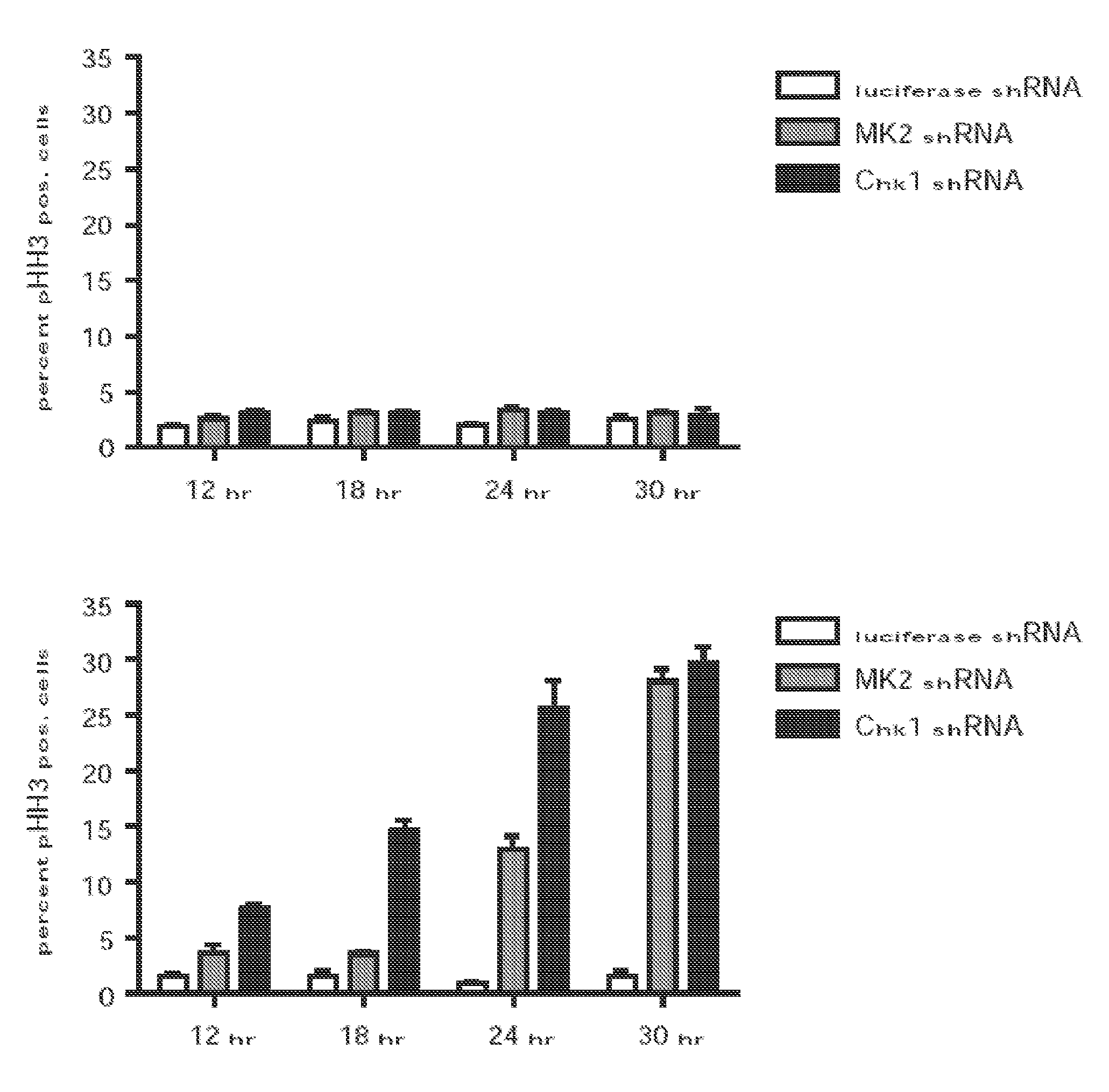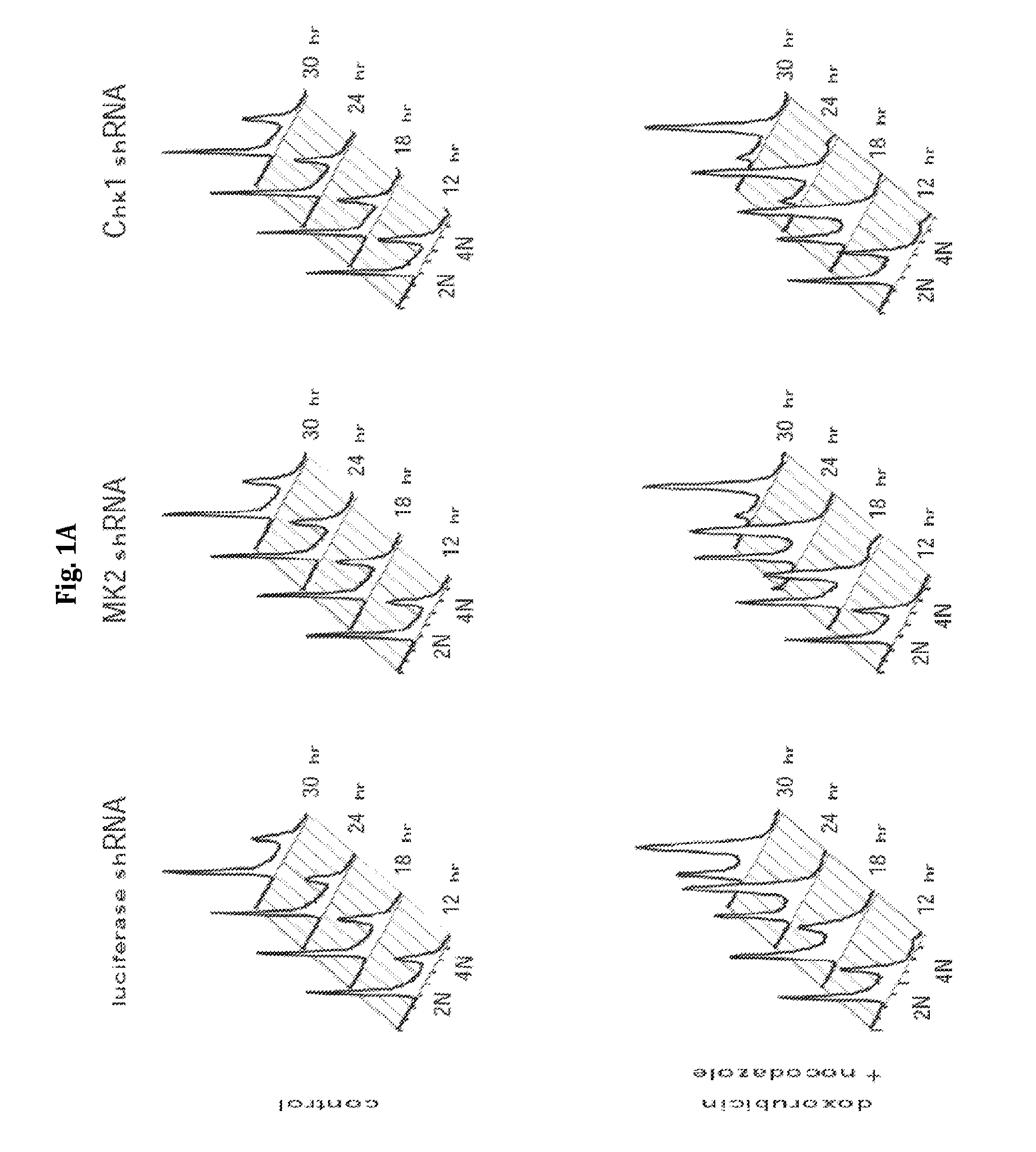Methods for Diagnosing and Treating Cancer
a cancer and molecular medicine technology, applied in the field of cancer biology and molecular medicine, can solve the problems of interfering with the processing/transport/translation and/or stability of the target mk2 mrna, and achieve the effects of increasing the disease-free survival time, slowing or stabilizing the progression of the condition, and inhibiting the progression of the diseas
- Summary
- Abstract
- Description
- Claims
- Application Information
AI Technical Summary
Benefits of technology
Problems solved by technology
Method used
Image
Examples
example 1
Chk1 and MK2 Control Early and Late G2 / M Checkpoints, Respectively, after DNA Damage
[0163]Experiments were performed to determine the role of Chk1 and MK2 in the G2 / M checkpoint in p53-deficient cells following DNA damage. In a first set of experiments, U2OS cells were infected with lentiviruses delivering luciferase-, MK2-, or Chk1-specific shRNAs. The ability of ability of these cells to engage and maintain functional cell-cycle checkpoint following genotoxic stress (1 hour of 1 mM doxorubicin) was analyzed using a FACS-based nocodazole trap experiment. The data from these experiments are shown in FIG. 1A and are described below.
[0164]As shown in the upper panels of FIG. 1A, knockdown of MK2 or Chk1 did not result in gross cell-cycle changes in the absence of DNA damage. Treatment of control cells with doxorubicin resulted in a gradual build-up of G2-arrested cells over 24 hours, as evidenced by the accumulation of 4N cells staining negatively for pHH3 (FIG. 1A, lower panels, and ...
example 2
Distinct Nuclear and Cytoplasmic Locations of Active Chk1 and MK2 Following DNA Damage Mediate Early and Late Checkpoint Functions
[0166]To investigate whether the different temporal kinetics of check point escape seen in the Chk1- and MK2-deficient cells resulted from targeting spatially distinct substrate pools, the subcellular localization of these two checkpoint kinases after genotoxic stress was examined. In these experiments, retroviral gene delivery was used to obtain stable low-level expression of GFP chimeras of Chk1 and MK2 in U2OS cells, and localization was monitored in live cells before and after DNA damage over time. Both GFP-Chk1 and GFP-MK2 localized exclusively in the nucleus of resting (untreated) cells, while GFP alone was diffusely distributed throughout both the cytoplasm and the nucleus (FIG. 2A). Following doxorubicin treatment, GFP-MK2 rapidly translocated from the nucleus to the cytoplasm, where it remained for at least 24 hours, whereas GFP-Chk1 remained nuc...
example 3
MK2 and p38MAPK Activity Results in Long Term Stabilization of Gadd45a Through Phosphorylation of Proteins Involved in RNA Binding and Degradation
[0173]MK2 has previously been implicated for a role in the stabilization of mRNAs containing AU-rich elements (AREs) in the 3′ UTR (Gaestel et al., Nat. Rev. Mol. Cell Biol. 7: 120-130, 2006). In order to identify likely substrates of MK2 that are critical for its late cytoplasmic checkpoint-maintaining function, a number of molecules potentially involved in cell-cycle control were surveyed for the presence of 3′ AREs. Gadd45a, a cell-cycle regulator known to be induced after DNA damage in both a p53-dependent and -independent manner, emerged as a likely candidate among the molecules initially identified. Gadd45a mRNA is rapidly upregulated following doxorubin-induced DNA damage, and accumulation of this mRNA was almost completely abolished when cells were depleted of MK2 (FIG. 4A). However, upregulation of Gadd45a mRNA following genotoxic...
PUM
| Property | Measurement | Unit |
|---|---|---|
| nucleic acid | aaaaa | aaaaa |
| nucleic acid sequence | aaaaa | aaaaa |
| genotoxic stress | aaaaa | aaaaa |
Abstract
Description
Claims
Application Information
 Login to View More
Login to View More - R&D
- Intellectual Property
- Life Sciences
- Materials
- Tech Scout
- Unparalleled Data Quality
- Higher Quality Content
- 60% Fewer Hallucinations
Browse by: Latest US Patents, China's latest patents, Technical Efficacy Thesaurus, Application Domain, Technology Topic, Popular Technical Reports.
© 2025 PatSnap. All rights reserved.Legal|Privacy policy|Modern Slavery Act Transparency Statement|Sitemap|About US| Contact US: help@patsnap.com



